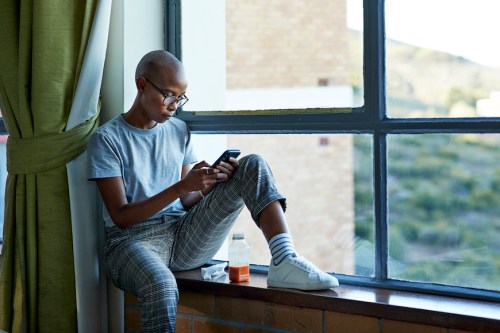Post-Traumatic Stress Disorder (PTSD) is widely viewed as a mental health condition brought on by a singular, emotionally damaging event: war, gun violence, a natural disaster, a near-death experience…But research is starting to show that it’s not just one singular event that can cause PTSD, but also the buildup of a thousand metaphorical cuts sustained over a lifetime.
Specifically, there is evidence that racial discrimination is connected to PTSD. When a Black person experiences microaggressions (indirect, subtle, or unintentional discrimination against members of a marginalized group) or repeatedly sees photos and videos of other Black people being physically abused and killed in their newsfeeds, it can lead to symptoms of PTSD. These symptoms, which include intrusive memories, flashbacks, mood changes, and trouble sleeping or concentrating, are disruptive and disturbing to those who live with them. Yet this pathway to PTSD often goes undiagnosed since it doesn’t necessarily line up with the Diagnostic and Statistical Manual of Mental Disorders-5 criteria, which is used to diagnose mental health conditions like PTSD.
Here, two mental health experts, who have studied the link between racism and PTSD, explain the connection and share how Black people can protect their mental health during this particularly traumatizing time where acts of racism and violence against Black people remain front and center of the news cycle.
How racial trauma can lead to PTSD
Antoinette Landor, PhD, an assistant professor at the University of Missouri who has studied skin-tone trauma, says repeatedly experiencing instances of racism can lead to the same feelings of stress and panic as one singular traumatic event. “[Think about] getting into your car in the morning and being trailed by the police. Maybe they pull you over and say it’s because they didn’t see your license plate. Then, you get in the elevator at work and a woman clutches her purse closely to her body, assuming you might take it. And then you go to your workplace and your colleagues and manager may be questioning your intelligence,” she says. “All these day-to-day variances can lead to PTSD, which is a reaction to these traumatic experiences that impact very effective human functioning, including both cognitive and behavioral components.”
Simone Bruce, PsyD, a therapist with the Behavioral Wellness Clinic, reiterates that when compounded, these experiences with racism can lead to someone living with a constant sense of panic. “[These experiences] can cause someone to develop a fear for their lives, a question of what’s going to happen next,” she says. “This can lead to living in a state of hyper vigilance, instability, and even feeling panicked.” One study of Black men and women living in low-income neighborhoods found that experiences of discrimination were linked to poorer physical health, mental health, and overall quality of life.
Dr. Landor says more blatant forms of racism can also lead to PTSD, from being teased at school from the color of your skin to being a victim of police violence or a hate crime. Both experts say that not only can experiences like this cause PTSD in the person experiencing it first-hand, it can also be traumatizing to be a Black person watching abuse of other Black people. “When you are a Black person and you see videos of George Floyd, Michael Brown, or others being abused and even murdered by the police, it can trigger a stress response,” Dr. Landor says.
“This is called vicarious trauma,” Dr. Bruce adds. “Vicarious trauma is when you aren’t the subject of the violence being depicted, but just watching it can trigger feelings of anxiety, stress, depression, anger, and dissociation, which describes mentally checking out.”
Just like with other causes of PTSD, both experts say that when left untreated, all of these experiences can lead to anxiety, depression, poor physical health, trouble concentrating at school or work, and higher rates of drug and alcohol abuse.
How to support your mental health during this particularly intense moment
It’s inarguable that footage of George Floyd’s death helped spur the outrage and momentum that sparked the latest round of Black Lives Matter protests. But again, that footage going viral has huge mental health implications for the Black people who see it in their feeds. Compounded with police violence against protestors across the country and more high-profile killings of Black Americans including Breonna Taylor, Robert Fuller, Riah Milton, and Dominique Fells, and it’s safe to say that this is likely a very traumatic time for Black Americans.
“We need these images out there so that people in power can see that this is really happening,” Dr. Bruce says. “But as a therapist, I often tell my clients that it’s important to take breaks from social media, the news, and seeing these images. We cannot consume them all the time.”
“I also recommend connecting to other people of color in your community, as research has shown that having strong ties to your racial or ethnic community can be protective,” Dr. Bruce adds. She says this gives you people to talk to who are likely feeling the very same emotions you are, which can help you feel less isolated.
Dr. Landor says it’s critically important that the DSM be updated to reflect the importance of acknowledging the connection between racial trauma and PTSD. Otherwise, clinicians may continue to miss the signs of trauma in their BIPOC patients, and may miss on asking key questions that could lead to a diagnosis. “It’s so important that this phenomenon be named because being able to recognize the signs [of PTSD due to racial trauma] is the first step to getting it treated,” Dr. Landor says. She encourages anyone experiencing feelings of fear, depression, anxiety, trouble focusing, or increased substance abuse to seek therapy. (These mental health resources specifically for Black women are a good place to start.)
Besides this, Dr. Landor says bigger, more systematic changes need to be made so that Black people stop experiencing racial trauma in the first place. “Institutional racism exists in many corners of our lives,” she says. “There needs to be institutional changes so people of color can thrive in society, not just survive.”
Sign Up for Our Daily Newsletter
Get all the latest in wellness, trends, food, fitness, beauty, and more delivered right to your inbox.
Got it, you've been added to our email list.











